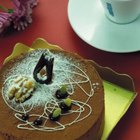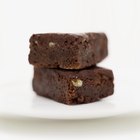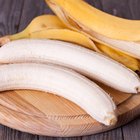
Espresso not only adds an expected coffee-flavored kick to your baked goods, but can also enhance chocolate, balance out sweetness, and add moisture. The way you add the espresso, though, depends on the recipe and type of baking you are doing. Though both brewed espresso and instant espresso impart the coffee flavor, adding a significant amount of liquid to a recipe can result in an improperly balanced batter or dough, throwing off the final result.
Brewed Espresso for Instant Powder
If you have access to freshly brewed espresso, you may wish to use it in the liquid form, rather than using instant espresso. For recipes that call for instant espresso reconstituted with water, simply substitute the same amount of fresh espresso. You can control the strength of the espresso if you are brewing it yourself, and adjust according to taste. However, if the recipe calls for instant espresso reconstituted in a ratio of less water to powder than typically used to make the beverage if you were simply drinking it, you need to brew your espresso significantly stronger for a one-to-one substitution, or add more espresso and adjust the dry ingredients to reflect this addition.
Instant Espresso to Pack a Stronger Coffee Punch
If your recipe calls for brewed espresso, but you want to increase the intensity of the espresso flavor, use instant espresso, instead. Because you reconstitute the instant espresso with water, you can use the same amount of liquid, but add a larger amount of the espresso granules, thereby making a significantly stronger brew. Alternatively, try using the called for amount of espresso and adding additional instant espresso powder directly into the batter or dough. The instant espresso dissolves in the moisture of the batter without changing the ratio of wet to dry ingredients.
Adding Espresso to Recipes
If you decide to modify a recipe to include espresso, you must consider whether the batter or dough can handle extra liquid and how you will balance it out with the other ingredients. For a light espresso flavor, you may be able to add a small amount of freshly brewed espresso and balance it out with a slightly higher amount of flour, resulting in a slightly moister baked good. However, to achieve a strong espresso flavor, consider using instant espresso mixed with only a tablespoon or two of water, in place of extracts. Or, for recipes such as cookie dough, add the instant espresso granules directly to the batter and mix well.
Other Considerations
For many recipes, such as cookie dough and some cakes, eggs are used not only as stabilizers and emulsifiers, but also to add moisture. To this end, if you desire to use freshly brewed espresso, rather than powder, reduce the number of eggs included in the batter or dough and add in espresso, with a little extra baking soda or powder. If you don't have instant espresso on hand for a recipe that calls for it, but do have espresso beans for brewing, you can create your own espresso granules. Instant espresso is made from already-brewed espresso grounds that are then dried and ground further, into a very fine powder. Take the leftover grounds from your morning espresso, dry them, and use a mortar and pestle to grind them further.
Related Articles

How to Make Espresso Using a Krups Il ...

How to Substitute Dried for Fresh Dill ...

How to Add Chicory to Coffee

Substitutes for Instant Espresso Powder
Flour Substitute for Muffins

How to Measure Coffee Grounds When ...

How to Flavor White Cake Mix With ...

Can You Make Brownies Without ...

How to Add Fresh Cranberries to Any ...

Will Adding Cocoa Powder to a Cake Dry ...

What Is a Good Substitute for ...

How to Make Boxed Chocolate Cake Better

How to Dissolve Non-Instant Milk Powder

How to Substitute Cocoa Powder for ...

How to Make Loose Tea in a Coffee Pot

How to Substitute Powdered Coffee ...
How to Add Flavor to a Yellow Butter ...

Can You Make Scones With Coconut Flour?

How to Cook Light With Bananas

How to Dilute Too Bright Fabric Dye to ...
References
- Baking and Pastry: Mastering the Art and Craft; The Culinary Institute of America
- On Food and Cooking: The Science and Lore of the Kitchen; Harold McGee
- Fine Cooking: Instant Espresso Powder
Resources
- The Professional Pastry Chef: Fundamentals of Baking and Pastry; Bo Friberg
- The Pastry Chef's Companion: A Comprehensive Resource Guide for the Baking and Pastry Professional; Glenn Rinsky
- On Food and Cooking: The Science and Lore of the Kitchen; Harold McGee
Writer Bio
Kathryn Roberts has worked in the culinary industry for nearly a decade in various roles, including pastry chef and bakery manager. After studying at the Culinary Institute of America, she earned her BFA from Goddard College and is pursing an MFA in Writing from Vermont College of Fine Arts.
Photo Credits
Eising/Photodisc/Getty Images